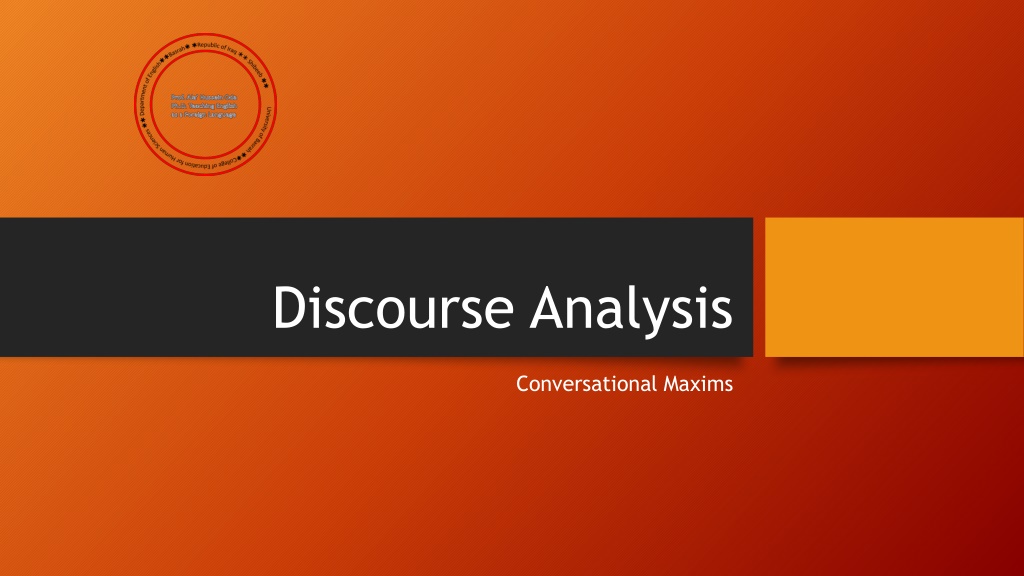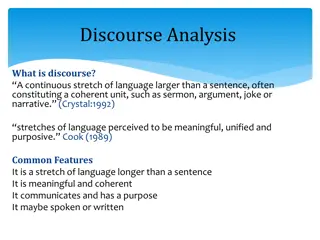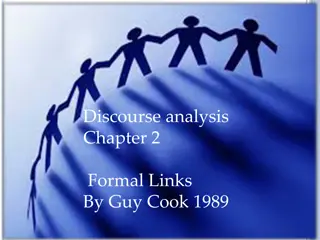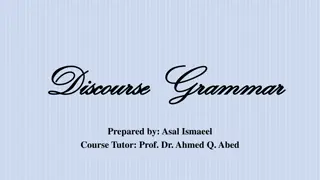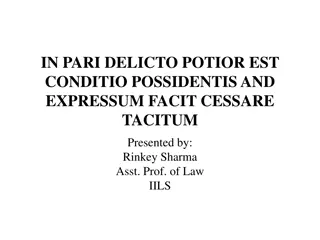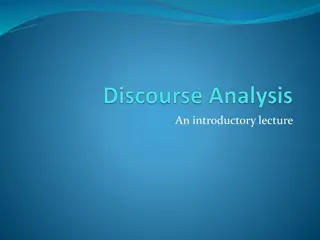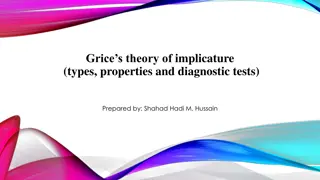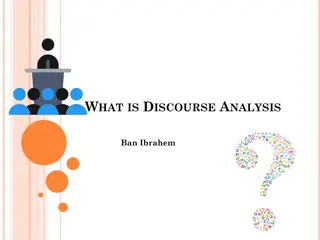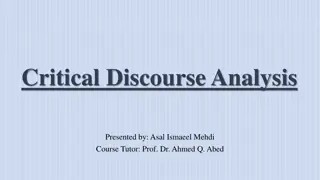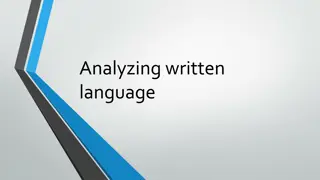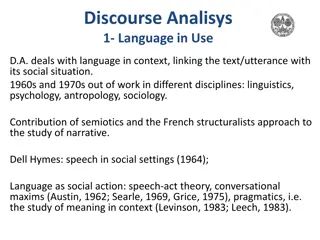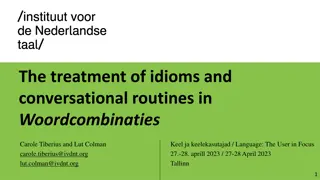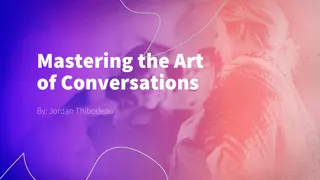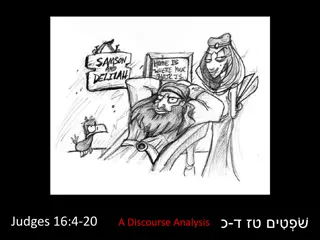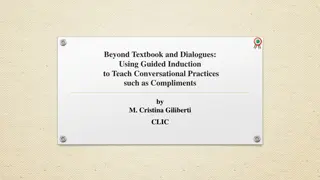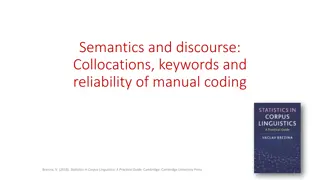Understanding Conversational Maxims in Discourse Analysis
Conversational exchanges are guided by the Co-operative Principle and Gricean maxims, focusing on quantity, quality, relation, and manner. Adherence to these guidelines ensures informative and relevant communication, although hedges are sometimes used to express uncertainty. Examples illustrate how participants navigate these principles in everyday conversations.
Download Presentation

Please find below an Image/Link to download the presentation.
The content on the website is provided AS IS for your information and personal use only. It may not be sold, licensed, or shared on other websites without obtaining consent from the author. Download presentation by click this link. If you encounter any issues during the download, it is possible that the publisher has removed the file from their server.
E N D
Presentation Transcript
Discourse Analysis Conversational Maxims
The Co-operative Principle An underlying assumption in most conversational exchanges seems to be that the participants are co-operating with each other. This principle, together with four maxims that we expect our conversational partners to obey,was first described by the philosopher Paul Grice. The co-operative principle is stated in the following way: Make your conversational contribution such as is required, at the stage at which it occurs, by the accepted purpose or direction of the talk exchange in which you are engaged (Grice, 1975: 45). Supporting this principle are four maxims, often called the Gricean maxims .
The quantity maxim: Make your contribution as informative as is required, but not more, or less, than is required. The quality maxim: Do not say that which you believe to be false or for which you lack adequate evidence. The relation maxim: Be relevant. The manner maxim: Be clear, brief and orderly.
It is certainly true that, on occasion,we can experience conversational exchanges in which the co-operative principle may not seem to be in operation. However, this general description of the normal expectations we have in conversation helps to explain a number of regular features in the way people say things
For example, during their lunch break, one woman asks another how she likes the sandwich she is eating and receives the following answer . Oh, a sandwich is a sandwich.
In logical terms, this reply appears to have no communicative value since it states something obvious and doesn t seem to be informative at all. However, if the woman is being co-operative and adhering to the quantity maxim about being as informative as is required , then the listener must assume that her friend is communicating something.
Hedges We use certain types of expressions, called hedges, to show that we are concerned about following the maxims while being co-operative participants in conversation. Hedges can be defined as words or phrases used to indicate that we re not really sure that what we re saying is sufficiently correct or complete. We can use sort of or kind of as hedges on the accuracy of our statements, as in descriptions such as His hair was kind of long or The book cover is sort of yellow (rather than It is yellow). These are examples of hedges on the quality maxim. Other examples would include the expressions listed below that people sometimes put at the beginning of their conversational contributions
As far as I know . . . , Now, correct me if I m wrong, but . . . I m not absolutely sure, but. .
We also take care to indicate that what we report is something we think or feel (not know), is possible or likely (not certain), and may or could (not must) happen. Hence the difference between saying Jackson is guilty and I think it s possible that Jackson may be guilty. In the first version, we will be assumed to have very good evidence for the statement
Implicature When we try to analyze how hedges work, we usually talk about speakers implying something that is not said. Similarly, in considering what the woman meant by a sandwich is a sandwich, we decided that she was implying that the sandwich wasn t worth talking about. With the co-operative principle and the maxims as guides, we can start to work out how people actually decide that someone is implying something in conversation. Consider the following example.
Carol: Are you coming to the party tonight? Lara: I ve got an exam tomorrow.
On the face of it, Laras statement is not an answer to Carols question. Lara doesn t say Yes or No. Yet Carol will immediately interpret the statement as meaning No or Probably not . How can we account for this ability to grasp one meaning from a sentence that, in a literal sense, means something else? It seems to depend, at least partially, on the assumption that Lara is being relevant and informative, adhering to the maxims of relation and quantity.
It is noticeable that, in order to describe the conversational implicature involved in Lara s statement, we had to appeal to some background knowledge (about exams, studying and partying) that must be shared by the conversational participants. Investigating how we use our background knowledge to arrive at interpretations of what we hear and read is a critical part of doing discourse analysis
Background Knowledge A particularly good example of the processes involved in using background knowledge was provided by Sanford & Garrod (1981), who presented readers with a short text, one sentence at a time. Their text begins with the following two sentences. John was on his way to school last Friday. He was really worried about the math lesson.
Most people who are asked to read these sentences report that they think John is probably a schoolboy. Since this piece of information is not directly stated in the text, it must be an inference. Other inferences, for different readers, are that John is walking or that he is on a bus. These inferences are clearly derived from our conventional knowledge, in our culture, about going to school , and no reader has ever suggested that John is swimming or on a boat, though both are physically possible, if unlikely, interpretations
likely or possible interpretations that readers will quickly abandon if they do not fit in with some subsequent information. Here is the next sentence in the text. Last week he had been unable to control the class. On encountering this sentence, most readers decide that John is, in fact, a teacher and that he is not very happy. Many report that he is probably driving a car to school. Then the next sentence is presented. It was unfair of the math teacher to leave him in charge
Schema A schema is a general term for a conventional knowledge structure that exists in memory. We were using our conventional knowledge of what a school classroom is like, or a classroom schema , as we tried to make sense of the previous example. We have many schemas (or schemata) that are used in the interpretation of what we experience and what we hear or read about. If you hear someone describe what happened during a visit to a supermarket, you don t have to be told what is normally found in a supermarket. You already have a supermarket schema (food displayed on shelves, arranged in aisles, shopping carts and baskets, check-out counter, and other conventional features) as part of your background knowledge.
Script Similar in many ways to a schema is a script. A script is essentially a dynamic schema. That is, instead of the set of typical fixed features in a schema, a script has a series of conventional actions that take place. You have a script for Going to the dentist and another script for Going to the movies. We all have versions of an Eating in a restaurant script, which we can activate to make sense of the following discourse
On the basis of our restaurant script, we would be able to say a number of things about the scene and events briefly described in this short text. For example, although the text doesn t have this information, we would assume that Suzy opened a door to get into the restaurant, that there were tables there, that she ate the sandwich, then she paid for it, and so on.
Indeed, crucial information is sometimes omitted from important instructions on the assumption that everybody knows the script. Think carefully about the following instructions from a bottle of cough syrup. Fill measure cup to line and repeat every 2 to 3 hours.
